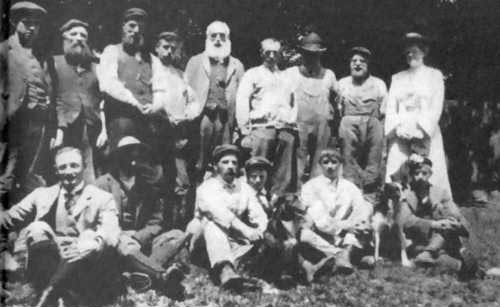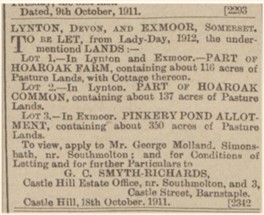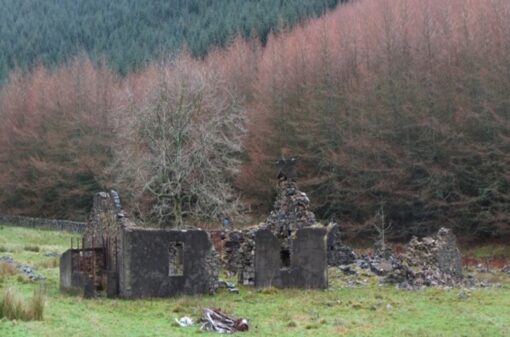Updated May 2024
Archie Jackson was born in 1870 in Newcastle/Northumberland of Scottish parents, John and Isabella Jackson of Roxburghshire. He had 2 brothers, John & James, and three sisters Margaret, Janet and Isabella and in the 1881 census the family were living in Selkirkshire on the Scottish/English border.
Christina Mitchell was born in 1881 in Philliphaugh in the parish of Selkirk. Her parents, George Mitchell and Annie Lawson, married in 1877. George already had five children and Annie had one son. Christina was their only child and the couple separated before Annie was 10 years old.
Archie married Christina in Selkirk in 1904, when he was 32 and she was 22, and soon after they travelled to Exmoor where Archie took over the Hoar Oak herding after James Maxwell Johnstone’s death in March 1904. Archie was employed by the Fortescue family and was the last Scottish shepherd to be employed at Hoar Oak Cottage. The photograph below shows Lady Margaret Fortescue (far right) with the Exmoor shepherds at shearing time in 1905. Archie Jackson is third from the left in the back row.

Archie had some success in sheep dog trialing on Exmoor as recorded in the North Devon Journal of July 1904. Sheep dog trials were introduced to North Devon as part of the new community of Scottish shepherds who, perhaps not unsurprisingly, did well at them and we learn that Archie Jackson of Hoar Oak won second place and prize money of 10 shillings and 6 pence.
Archie seems to have had less success keeping the Fortescue Land Agent – George Cobley Smyth-Richards – happy as Smyth-Richard’s diaries record not only that the cottage was damp but that Archie seemed less than competent as a shepherd. Entries include:
16 April 1906 “I rode over to Hoar oak and saw Jackson and had a look around and I decided to have the East wall tarred and probably the front cemented if it was required. “
1 March 1907 “I also saw young Little of Pinkery who complained that Jackson had smacked his face.”
2 March 1907 “I had Jackson in to see me and had a long talk with him as to his herding and I told him he must manage better or I must change him and I particularly gave him instructions as to his skins. I found he had not brought in these.”
5 September 1907 “Saw his Lordship and discussed the matter of the Hoar Oak sheep. There are 30 missed there and the question is how so many can have been missed.”
9 September 1907 “We [George Cobley Smyth-Richards and Lord Fortescue] rode back across to Hoar Oak. Inspected the farm and the herding. Personally his Lordship was of opinion it would pay to let it, but I am not of that opinion for the herding would be spoilt.”
13 January 1908 “I had a long talk with his lordship as to the sheep in the Oar Oak [corrected to read Hoar Oak in the margin] herding and it appears to me that Jackson should have notice to leave.”
27 January 1908 “Had a look at Hoar Oak House and found it very damp and decided to tar the whole of the outside and see if that will keep it dry.”
Diaries held at Devon Record Office Ref: DRO1262M/E26/3 et seq
The reader will note that two years elapse between the diary entries – two years of dampness for Christina who had her first baby to care for and a second baby on the way. And possibly two years of uncertainty about her husband and his job security. The family are still at Hoar Oak in 1911 according to the Census Records (below) for that year which also tells us that Archie and Christine Jackson had two children at Hoar Oak Cottage – a son John born in 1906 and a daughter Isabella born in 1909.

These were hard times for agriculture, including on Exmoor, and Roger Burton in his book The Heritage of Exmoor (1989) notes that not only were the prices received for meat and wool poor at this time but also that Viscount Ebrington, the heir to the Fortescue Estate, and his Agent George Cobley Smyth-Richards were seeking to wind up much of the sheep farming on Exmoor. Their aim was to free up the farms and farmhouses in order that they could be let out to tenants. In this way the Fortescue Estate could earn income but also avoid the expense of shepherds and their wages and their homes. This had a grave impact on the shepherds and their livelihoods and Burton notes that the proposed sale or letting of tenancies of many of the sheep farms caused, not unsurprisingly, friction between the shepherds and the Agent. The advert, below, from the North Devon Journal shows that on the 9th of October, 1911 Hoar Oak ‘Farm’ was advertised to be let by the Fortescue Estate from Lady Day 1912 –the 25th March.

The exact departure date for the Jackson family is not recorded but Christina and Archie faced the chore of packing up and taking the long journey back to Scotland. What happened next is not entirely clear but in 1912 Christina had her 3rd child William born in Caddonfoot in the Scottish borders. During the 1920s and 1930s we find the Jacksons in East Lothian, then Seathope and then Innerleithen where Archie was working as a shepherd and they were living in Priesthope Cottage – now a ruin shown below.

Christina died in Edinburgh Royal Infirmary in 1940 from pancreatitis. Archie survived her by 10 years and both children John and Isabella married and lived locally.
The chapter on Christina Jackson nee Mitchell in “The Women of Hoar Oak Cottage – An Untold History” contains more details about this family and their life at Hoar Oak Cottage.
To get a copy go to:
- Books4Sale – hoaroak (hoaroakcottage.org)
- https://hoaroakcottage.org/books4sale/
- email: info@hoaroakcottage.org
There is still more to learn about the Jacksons. If anyone has further information, please contact us.
Thanks go to Graham Wills for sharing his research into the Fortescue Estate Land Agent’s diaries which have helped to fill in some of the story of Archie Jackson.
